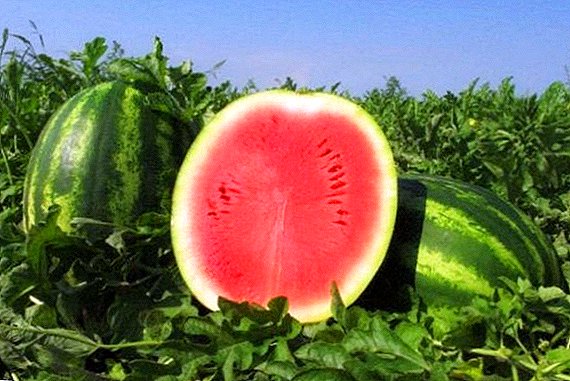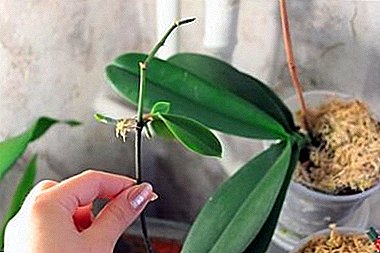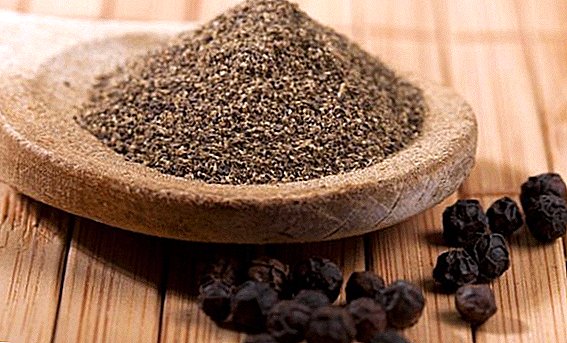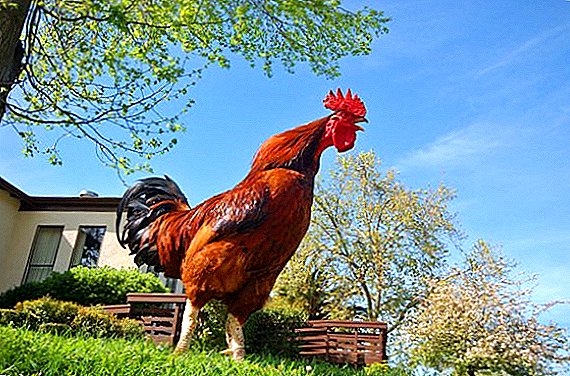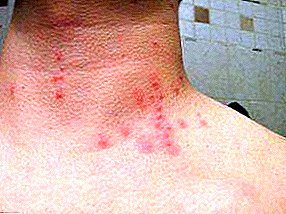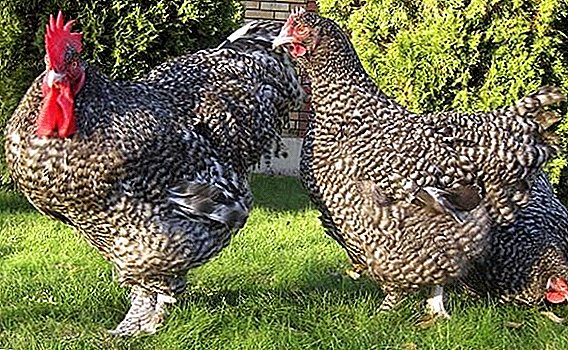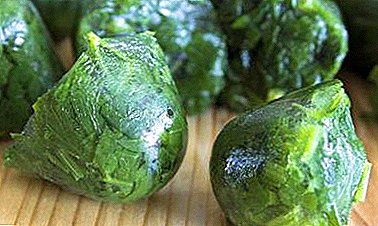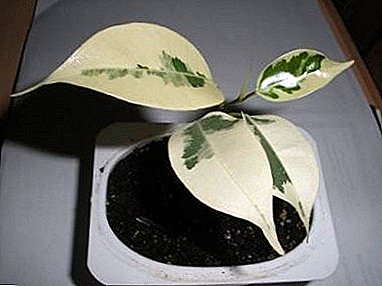
Ficus de dumbbell is one of the many varieties of ficus Benjamin, it differs from other varieties in leaf color.
The leaves of this variety of ficus Benjamin mostly white in color with small green splashes.
This type of ficus benjamin is the whitest.
Family: Mulberry - Moracea.
Homeland: Wet subtropical forests of China and Japan.
Home care
Caring for the ficus de dumbbell does not require special skill, but rather accuracy.
Important! In the growth stage of ficus, it is necessary to dilute liquid type fertilizers in water, following the instructions on the package and water it, while feeding the resulting mixture once in 14 days.
If a simple spraying badly relieves the leaves of ficus de dumbbell from contamination, then you can use cleansers, but you can not abuse them, it is recommended to apply rarely, about once in two months, and even less often.
The basis for the soil of the plant is turf soil, and if you add an admixture of horn shavings, it will increase the beneficial properties of the soil for 3-4 years.
Attention! If your ficus has grown very much, it is necessary to cut it in the spring, as soon as active growth begins, and most importantly do not forget to put charcoal on the cut areas, this should be done in order to stop the selection and loss of juices.Adult ficuses tend to give air rhizomes, like philodendrons, so they cannot be pruned.
 In the summer season from 18-23 ° С, and in winter not lower than + 15 ° С. Variegated species are more demanding to heat.
In the summer season from 18-23 ° С, and in winter not lower than + 15 ° С. Variegated species are more demanding to heat.
Like all ficuses, this one also loves moisture.
It needs to be sprayed daily with slightly warm water, especially in winter, as the air becomes drier.
After the heating is turned on, the plant should be removed approximately on 2 meters, or even more.
Batteries dry the air, and this is the most common cause of falling leaves in winter.
Place should choose light. In bright light, the coloring of variegated forms look more expressive, but all the same, it is necessary to avoid exposure to direct sunlight, it would be best to arrange it 1 meter from the windowfacing south.
In winter, the plant may need an additional light source, since with its lack of the likelihood of loss of leaves is great.
Attention! It is impossible to unfold and move the plant too often, since these actions will also lead to the falling off of the leaves of one side of the plant.
Watering mode
In the summer you need to water regularly with soft warm water. (preferably separated or passed through a filter) once every three to four days, before the next watering the ground should dry slightly.
If the plant is to be poured, the leaves turn yellow and fall off, you also have to carefully watch that the roots never get too wet and the water does not cover them. However, even with a lack of water, the ficus can also become “balder”.
In the winter season, water once a week and a half.
Important! This type of ficus does not require too much watering, in this case its foliage turns yellow and it drops it.
Transfer
 Transplantation is carried out once a year, usually in spring. Carrying out the care of adult ficuses, during the spring period, experienced flower growers recommend replacing the surface part of the soil in a pot or other substrate.
Transplantation is carried out once a year, usually in spring. Carrying out the care of adult ficuses, during the spring period, experienced flower growers recommend replacing the surface part of the soil in a pot or other substrate.
Young ficus grow rapidly, and for the development at this time he needs a large amount of minerals and vitamin supplements.
To do this, in order to avoid starvation of the plant, every April it must be transplanted into a new soil, which is a mixture of deciduous,
fertile and sod soils with sand. If you have pots, then a layer of drainage material is covered to the bottom.
Breeding
Ficus simple enough may root when grafting in spring.
The process of reproduction of ficus in greenhouse conditions begin in early March. Each stalk should have only one leaf, the main thing is not to damage the eye, and half of the lower node without a peephole. With one branch, you can get several cuttings, depending on how many leaves are on it.
In order for rooting to happen as best as possible, the bottom of the cutting is recommended to make an incision or split cross-shaped, somewhat if the wood is hard, and with soft one will be enough.
Rooting cuttings occur in greenhouse conditions in moistened sand. You can also prepare a mixture of sod land, in proportion 1 part humus, 1 part leaf, 1 part sand.
After the rooting process is successful, they can be safely transplanted into pots.
The juice they release must be washed off with water, and then they are transplanted into an exploration box or on a rack, and in it, for their maintenance, it is necessary to maintain a fairly high temperature. 25-30 ° mode.
After successful rooting of the cuttings, they are transplanted into 9-centimeter pots.
At this crucial moment, special care should be taken when watering and spraying, young shoots, and in pruning times, pritenka will help.
The same method can protect the plant from the heat in greenhouses and greenhouses, as well as prevent excessive loss of moisture from the leaves of cuttings, and freshly transplanted plants.
 As the coma of the earth becomes entwined with roots, a transshipment is needed, it is just a displacement of a plant.
As the coma of the earth becomes entwined with roots, a transshipment is needed, it is just a displacement of a plant.
Around mid-late July, young ficuses gradually adapt to the sunlight, for which they are moved closer to the light source.
With this approach to business, by the beginning of autumn plants will develop and grow strong enough.
If you are engaged in ficuses in an apartment, then they are usually made to propagate with top cuttings, they can be easily fixed in a container with water, a regular bottle will fit, which must be placed in a place lit by the sun.
If you want to propagate your ficus with seeds, you need a fairly high temperature range 25-30 °.
Seeds are sown in leaf soil with the addition of sand.
As soon as the first leaf appears, the seedlings need to swoop down, and after a short time their landing in 7-centimeter substrates is possible.
Crown formation
There is some trouble in the care of this ficus, it is competent to make a crown. One of the important tasks of proper care for the ficus at home is to form the crown in time and according to all the rules, because having mastered this science, your body will have the right look that will delight you and amaze your guests.
Important! Vertically growing shoots he is rather weak and almost immediately go into a horizontal position.At home, this remarkable can cause uneven growth and as a result, a poorly developed crown.
In order to keep the bush in the correct position, often not one seedling is planted in the pot, while weaving young shoots as they grow.
At the same time in the place of their contact there is an accretion of trunks. This will help the vertical peg, for which you should tie a young escape to help him grow straight.
After reaching the escape height and the desired thickness, the support will not be needed and it can be removed.
Ficus de dumbbell as if created for a haircut and, thanks to its small leaves, from it you can even try to create a green sculpture.
A photo
In the photo ficus "De Gunthel":





Diseases and pests
Your ficus loses foliage? This is a very frequent occurrence and it happens because of a deficiency of the sun or strong drafts. They are actually destructive for all ficuses!
For the recovery of ficus, move your pet to a more lighted place, where drafts will not interfere with it.
Reference. Benjamin's ficus (de dumbbell) throws off foliage if it is too wet, especially in autumn and winter.
Let the soil dry until the plant comes to life, and later change the watering mode, watering less.
Unfortunately, even in the conditions of a city apartment, it is practically impossible to protect your ficus from the invasion of harmful organisms.
 Ficus de Dumbbell Care also involves periodic monitoring of the plant to prevent the appearance of parasites and pests.
Ficus de Dumbbell Care also involves periodic monitoring of the plant to prevent the appearance of parasites and pests.
Most species of Benjamin ficus have leaves of different shapes, it all depends on the variety, this fact can make it difficult to detect the spider mite during its time, its appearance causes a gradual change in the shape of the leaves, as for example, in adenium.
If the leaves have lost color, become dull, small brown insects appear on the inside of the leaves, with a strong lesion on all parts of the plant, then this is a sign of the scythes.
Many varieties of ficus Benjamin are very sensitive to this type of pest.
They can be removed with a piece of cotton dipped in methyl alcohol, or sprayed with a systemic insecticide can be helped by a soap solution.
Important! If the leaves of the Benjamin Ficus turned yellow, and the bottom of the cobweb, then it is a red spider mite.
Here, spraying with acarin or any suitable insecticide will also help, as well as increasing the humidity of the environment. If the lesion area is not very large, then it is worthwhile to begin to apply biological methods of struggle.
With proper care, the ficus de dumbbell will delight you for a long time with its beauty, which you yourself will create, to be proud of yourself and even to the envy of your guests, to white envy.


